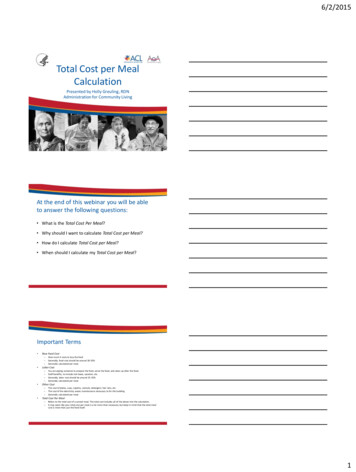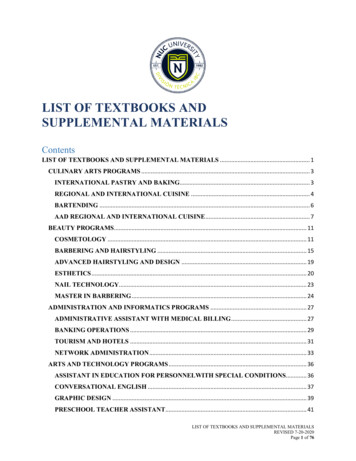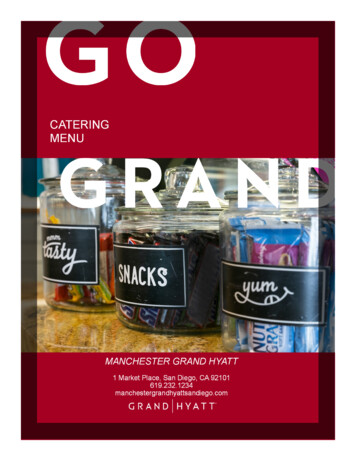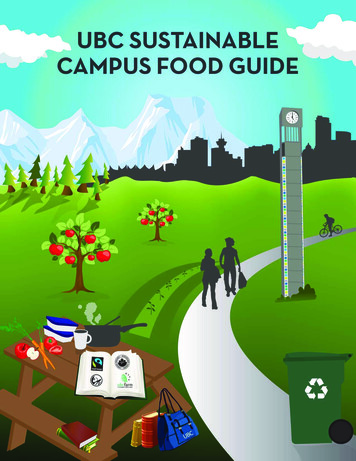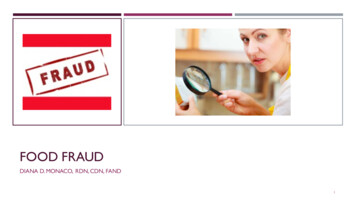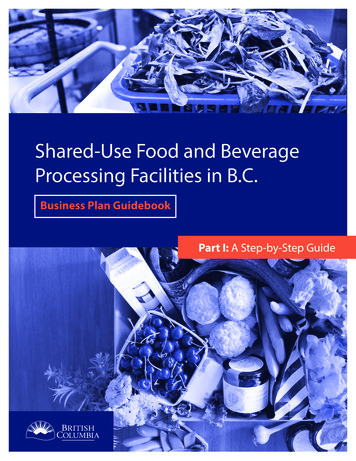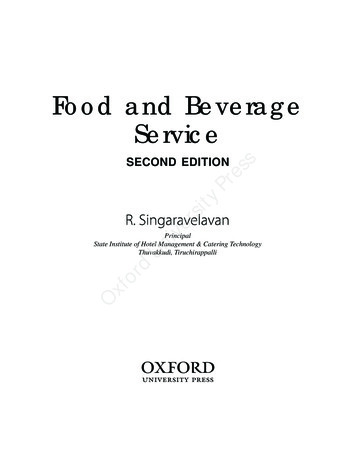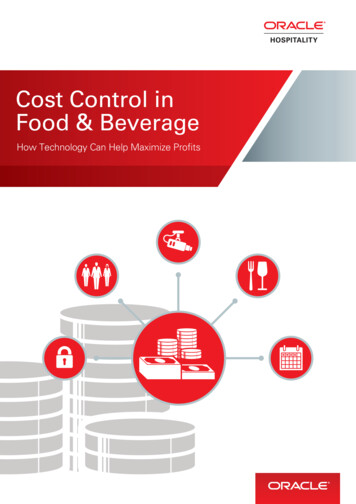
Transcription
Cost Control inFood & BeverageHow Technology Can Help Maximize Profits
Cost Control in Food & BeverageINTRODUCTIONThe research findings aredesigned to helpquantify the significance ofback-office functions and,more importantly, shedlight on the ramificationsthey have on somany other facets ofthe operation.Great food and great service, delivered consistently, are at the heart of anysuccessful restaurant business.But success — and survival — also depend on being profitable. Every restaurantowner, whether independent or part of a large chain, understands that labor andinventory costs represent a significant variable expense to the business. Keepingcontrol of those costs is as critical as the culinary magic that occurs in the kitchen.After all, how can a restaurant expect to make a profit when they are regularlyoverstaffing or running out of ingredients?The same goes for loss prevention — if a restaurant owner is losing money throughshrinkage or waste but has no way of tracking it, how can the business succeed?In this research report, Oracle Hospitality partnered up with Technomic to surveymore than 200 independent operators and chains. We wanted to understand howthose operators are managing the task of controlling the costs of labor, inventory,and loss prevention. Where do their priorities lie? What are their biggest issues?How can the task of managing costs become more efficient?By sharing the findings of the research with food and beverage operators globally,Oracle Hospitality aims to show that managing labor, inventory, and loss preventionis a global challenge that can be met by putting cost-control technology at the veryheart of your operation.How Technology Can Help Maximize Profits oracle.com/hospitality2
EXECUTIVE SUMMARYHow much of a restaurant’s revenue is spent on food and labor costs? Where arerestaurants losing money? What are the key priorities when it comes to managingThough thesestaff and inventory? These are just some of the questions that we asked our 200back-office problems arerestaurant operators, to help us establish the importance of cost control in a foodsignificant, food andand beverage operation, and how it can be improved. Among the key findings:beverage operatorsare finding an allyin cloud-based technologyto resolve them.1. Labor and inventory, on average, combine to account for more than 50% ofrevenues. The magnitude of their impact on budget clarifies priorities: Food and beverageoperators must make cost control a key part of their operation. To offset labor costs, twothirds of independent operators reported raising menu prices — directly impacting the guestexperience.2. Valuable time is often diverted and wasted on labor scheduling. Food & beverageoperators resoundingly rank recruitment, training and retention as top priorities for labormanagement, yet often find themselves mired in the mundane: 63% of restaurants changeschedules prior to posting and 49% do so after posting. What’s worse, even after all theseadjustments, 44% reported that understaffing is an issue, which can impact the diningexperience.3. Inventory management also takes up valuable time. A third of operators said thatthey spend more than 3 hours per week managing stock, when the top priorities forinventory actually lie in meal quality and kitchen staff empowerment.4. Over-portioning and food waste are among the primary loss culprits. But 50% ofindependent operators said they do not track prepared waste. Furthermore, 60% reportedthey do not use a forecasting system to improve ordering, which likely contributes to thewaste problem.There is no doubt that cost control needs to be a significant priority for any food andbeverage operation. By using technology to manage labor, inventory, and loss, operatorscan increase efficiencies while reducing the manual effort needed to achieve maximumcontrol — releasing that time for other priorities.How Technology Can Help Maximize Profits oracle.com/hospitality3
LABOR MANAGEMENT
LABOR MANAGEMENTFinding #1: Labor makes up a quarterof revenueFor enterprise and independent operators alike, labor accounts for roughly a quarter of totalrevenues. And a sizeable percentage of limited-service restaurants (17%) and full-serviceestablishments (13%) reported spending a staggering 30% or more of revenues on staffing.To offset high labor costs, restaurateurs almost inevitably boost menu prices: Indeed, twothirds of independent operators reported taking such action, and 38% of operators who hadnot raised prices said they planned to do so in the next six months. The cost of labor is oneof the most significant factors in a restaurant business, and consequently, its variation canhave a rippling affect across all operations. Which explains why controlling it is of paramount9% 15%importance.15–20%24%20–25%Technology Tip:Technology helps corral34%LABOR COSTS AS25–30%% OF SALESHOURLY MANAGEMENT30% labor cost in various16%17%ways — with tools thatbuild efficient scheduling,track staff hours andretain top employees. 15% 15%9%15–20%15–20%24%20–25%48%25–30%16%30% 13%20–25%34%25–30%3%17%30% LSR23%13%Limited Service Restaurant 15%FSRFull Service Restaurant3%15–20%13%20–25%48%INCREASED MENU PRICES TO23%OFFSET LABOR COSTS25–30%30% 13%Quick ServiceQSRRestaurant74%26%Fast Casual74%26%Midscale36%64%YESNOCasual DiningCDRRestaurantFine Dining29%71%45%55%How Technology Can Help Maximize Profits oracle.com/hospitality5
LABOR MANAGEMENTFinding #2: Training, recruitmentand retention are the top labor concernsTraining, recruitment and retention — enterprise and independent operators wholeheartedlyagree that these are their top priorities when it comes to labor, ahead of other concerns suchas productivity and government regulations. In an era of individualization, when customerscovet personalized attention and service, it is critical for restaurants to hire first-rate staffand train them to meet, if not surpass, marketplace expectations. To carve out appropriatetime to address foremost priorities, management needs to simplify and efficiently handle“processing tasks,” including new employee onboarding and training delivery.Technology Tip: Cloudsolutions can simplifyTOP LABOR CONCERNSonboarding, delivertraining efficientlyand empower employeesto better manage theirschedules — providing the70%66%67%65%73%Training employeesingredients for a happier,Recruiting employeesRecruting68%60%61%59%67%Retaining employees58%58%59%connected rnment regulations32%15%41%58%6%Poor forecasting softwareQUICK SERVICEFAST CASUALQSR14%15%21%9%MIDSCALECASUAL DININGFast CasualMidscaleHow Technology Can Help Maximize Profits oracle.com/hospitalityFINE DININGCDRFine Dining6
LABOR MANAGEMENTFinding #3: Schedules are frequentlychanged before and after postingStaff schedule changes are a fact of life; 63% of restaurants either “frequently” or“somewhat frequently” change schedules prior to posting, and 49% “frequently” or“somewhat frequently” make changes after posting. Such frequency suggests that betterprocesses are required to minimize the time and effort required to manage these changes.Indeed, with far more pressing tasks to tackle, half of the independent restaurants surveyedwill encourage staff to use their own mobile devices to manage schedules, and 51% ofthose plan to introduce it in the next six months.Technology Tip:Technology can helpPRIOR TO POSTINGAFTER POSTINGmanage one of theheadaches of the business:schedule changes. It canLimited ServiceLSRRestaurant20%Full 15%33%48%4%enable employees toelectronically make their38%38%own changes, and keepoperators abreast ofFREQUENTLY & VERY FREQUENTLYSOMEWHAT FREQUENTLYRARELYNEVERstaffing needs.OPERATORS PLANNING TOHAVE EMPLOYEES USE OWN DEVICESTechnology Tip: Equippingstaff with better tools todo their jobs, such asmobile devices, fosters asense of “ownership”in their work — andLimited ServiceLSRRestaurant45%Full ServiceFSRRestaurant55%50%makes managers’ livesNO50%Yeseasier, too.YESNoWHEN WILL THIS BE REQUIRED?44%24%Limited ServiceRestaurant40%Full ServiceRestaurant26%20%16%11%10%4%Already required1–3 months3–6 months6 months – yearHow Technology Can Help Maximize Profits oracle.com/hospitalityLSRFSR4%1 year 7
LABOR MANAGEMENTFinding #4: Understaffing is an issue44% of independent operators say understaffing occurs “somewhat frequently” ormore often, despite all the scheduling and changes to schedules that we saw on theprevious page. The issue is most pervasive in fast-casual restaurants, with 54% reportingunderstaffing as a somewhat frequent or more frequent issue. By comparison, only 24%of independent operators said overstaffing was an issue. Ever watchful of labor costs, it isno surprise that restaurants err on the side of understaffing when it comes to schedulingpractices, but such findings remind us that the guest experience can be jeopardized byoverstretched resources.Technology Tip: Forecastingtools do more than justproject sales; they can pullUNDERSTAFFING IS A CHALLENGEdata from POS systemsand automatically buildstaff schedules thatfactor in labor costs andQuick ServiceQSRRestaurant16%28%52%4%productivity needs.Fast Casual6%Midscale6%Casual DiningCDRRestaurantFine Dining48%27%15%12%FREQUENTLY & VERY FREQUENTLY38%21%9%58%32%47%55%SOMEWHAT FREQUENTLYHow Technology Can Help Maximize Profits oracle.com/hospitality8%6%12%RARELYNEVER8
LABOR MANAGEMENTFinding #5: Changing governmentregulations are a big concernFor 33% of operators, government regulations are among their biggest concerns, especiallyas they relate to minimum wage legislation. To counter rising wages, the most commonmeasures taken by restaurants include restricting the amount of hours an employee canwork and creating split shifts. Such actions, managers said, place a greater premium ontechnology solutions that can alert them when their employees are approaching overtime orwork-hour limits.Technology Tip: Stayingon top of regulationsgoverning wages andbenefits is a challenge,“Lowered staffing levels due to minimum wage,have created many split shifts to minimize slow anddown times.”but technology can helpensure compliancy.Solutions such asOracle HospitalityinMotion, for example,sends alerts if anemployee is approachingovertime.“We look for efficiencies in operations—equipment, recipes, BOH layout—and how tocapture areas of waste by tracking trends and peaksto maximize productivity with minimal staff.”“We have to do more with less, and given thejob market is strong, that makes it doubly-hard tofind quality people.”How Technology Can Help Maximize Profits oracle.com/hospitality9
INVENTORY MANAGEMENT
INVENTORY MANAGEMENTFinding #1: Food cost accounts for25% or more of revenuesFood cost, along with labor expense, rank first and second, respectively, when it comes toconsuming restaurant revenues. In fact, more than 71% of independent operators said foodcost accounts for 25% or more of revenues, including 10% who reported that the line itemexceeded 35%. By comparison, only 6% said they managed to keep food cost under 20%.Considering its super-sized impact, inventory cost is a lynchpin for financial success — andgetting it under control is an absolute priority.Technology Tip:Menu-modeling solutionsFOOD COST AS PERCENTAGE OF SALESevaluate margins whenfood costs rise, givingrestaurateurs optionsto alter recipes or adjustmenu prices. ��35%35% 20%10%Fast CasualMidscaleQUICK SERVICEMIDSCALEFAST CASUALCASUAL DININGHow Technology Can Help Maximize Profits oracle.com/hospitalityCDRFine DiningFINE DINING11
INVENTORY MANAGEMENTFinding #2: Over-portioning andfood waste are the greatest areas of lossOver-portioning and food waste are considered the two biggest factors for loss, accordingto nearly a third of all operators surveyed. They dwarf other factors that certainly canundermine a restaurant’s financial health: giving away of food (13%), incorrect ring-ins (12%),theft (9%) and unapproved discounts (4%). The good news is, the top issues can be curbedthrough education and monitoring. Training staff with proper guidelines can minimize overportioning, and addressing waste by making it a priority and tracking it accurately can be aneffective deterrent.Technology Tip: Bettertraining and monitoringAREAS OF GREATEST LOSScan address some ofthe industry’s mostpersistent problems,and technology helps onboth fronts: POSOver portioning18%systems can print recipe32%Wasteproperly and be used27%to track waste — keepingemployees committedto tasks.32%20%cards to prepare dishesGiving away food14%15%6%6%9%8%Theft0%Unapproved discounts2%9%32%45%39%20%10%10%12%Incorrect K SERVICEMIDSCALEFAST CASUALCASUAL DININGHow Technology Can Help Maximize Profits oracle.com/hospitalityFINE DINING12
INVENTORY MANAGEMENTFinding #3: Food consistency andstaff empowerment arethe top inventory concernsDelivering consistent food preparation and meal quality (68%), and cultivating a sense of“ownership” among staff for their work in the kitchen (64%) were among the top inventorymanagement concerns cited by independent operators. The two issues are understandablylinked, because staff members that care about their craft invariably lead to better preparationand quality meals. Using kitchen display systems can play an instrumental role on this front:By helping maintain recipes and guiding proper food preparation, they help “teach” staff,fostering confidence, competence and a sense of empowerment.Technology Tip: Kitchendisplay systems can helpmaintain recipes andTOP ISSUES FOR MANAGING INVENTORYprovide the resources tomake sure staff knows howto best prepare food.68%72%70%68%61%Consistent foodquality/prep58%56%Staffing ("caring"about %Manual %QUICK SERVICEFAST CASUALQSRMIDSCALEFINE DININGCASUALDINING MidscaleFastCasualHow Technology Can Help Maximize Profits oracle.com/hospitalityCDRFine Dining13
INVENTORY MANAGEMENTFinding #4: Operators spend more than3 hours a week managing inventoryOperators need to extract efficiencies from across their enterprise, and one task thatcan stand obvious improvement is stock management: About one-third of independentoperators reported spending more than three hours per week managing inventory.Automating “processing tasks,” such as stock counting and ordering process, improvesspeed and accuracy. Just as important: Automation does more than minimize themundane; it creates time to innovate.Technology Tip: MinimizeTIME SPENT MANAGING INVENTORYthe mundane. An inventorymanagement systemautomatically calculates10%4%6%9%3%totals and volume,allowing you to spend 1 hoursless time counting stock,while employing greateraccuracy.6%30%16%1–2 hours24%44%21%28%2–3 hours39%18%44%4%4 hoursQSR12%9%12%Fast Casual22%10%18%MidscaleQUICK SERVICEMIDSCALEFAST CASUALCASUAL DINING34%42%28%24%21%18%15%3–4 hours26%CDRHow Technology Can Help Maximize Profits oracle.com/hospitalityFine DiningFINE DINING14
INVENTORY MANAGEMENTFinding #5: The web is the preferredchoice for ordering stockFor most types of restaurants, the web is the preferred channel choice for ordering stock.Indeed, 70% of mid-scale restaurants rely on the web, and so do 60% of all independentoperators surveyed. B2B ordering is another common means, typically outpacing otheroptions such phone, email and in-person ordering. However, all of these options are failingto capitalize on a valuable efficiency: By integrating inventory management and ordering,restaurateurs can increase accuracy and reduce manual effort, freeing up time for morepressing tasks.Technology Tip: Orderingstock remains a timeconsuming, manual taskDISTRIBUTOR ORDERING CHANNELSfor many. By integratinginventory management60%52%and ordering, faxingor emailing orders toWeb70%62%64%distributors becomes athing of the past: Orderscan be sent right throughthe POS.62%54%B2B 22%21%Email29%36%6%In-person18%30%38%21%QUICK SERVICEFAST CASUALQSRMIDSCALEFINE DININGFast CASUALCasualDININGMidscaleHow Technology Can Help Maximize Profits oracle.com/hospitalityCDRFine Dining15
INVENTORY MANAGEMENTFinding #6: Most operators do not useautomated forecastingBy employing automated forecasting tools to enhance direct purchasing, operators can reapimmediate benefits: Most notably, accurate orders mean carrying fewer items in storage andusing less labor time to sort through deliveries or resolve shortages. Surprisingly, however,60% of independent operators are not taking advantage of integrated inventory systemforecasting tools to create stock orders. The exception to the rule: 64% of quick-servicerestaurants have embraced automated forecasts for purchasing.Technology Tip: Thebenefits of forecastingtools extend farPURCHASING DRIVEN BY AUTOMATEDFORECASTSbeyond just placingmore accurate orders;they mean carrying lessQuick ServiceQSRRestaurant36%64%inventory andfewer headachesmanaging deliveriesFine Dining55%45%and shortages.MidscaleFast CasualCasual DiningCDRRestaurant39%28%21%61%72%79%YESNOHow Technology Can Help Maximize Profits oracle.com/hospitality16
INVENTORY MANAGEMENTFinding #7: Half of operators do nottrack prepared waste50% of independent operators do not track prepared waste, despite waste being one ofthe biggest areas of loss to a restaurant business. Failing to track prepared waste is akin toignoring losing money. But as difficult as it may be to comprehend, such indifference is fairlyconsistent among all restaurant types. On the bright side, among those who do track, 71%have a waste-tracking system integrated with their point-of-sale system.Technology Tip: Using awaste-tracking systemintegrated with a POSOPERATORS TRACKING PREPARED WASTEsystem is the mostefficient way to monitormoney being lost. MoreFine Dining52%48%Quick ServiceQSRRestaurant50%50%importantly, it’s a greattool to help hold everyoneaccountable.Fast Casual46%54%Midscale45%55%Casual DiningCDRRestaurant44%56%YESNOHow Technology Can Help Maximize Profits oracle.com/hospitality17
LOSS PREVENTION
Maximize ProfitsLOSS PREVENTIONFinding #1: Shrink preventiontraining is conducted at least once peryear for 26% of operatorsCasual-dining restaurants lead the way when it comes to training staff on shrinkage: 26%carry out training programs at least once per year, and 41% conduct such training even morefrequently. By simply using an inventory or loss-prevention solution, operators send a clearmessage to employees that they are being vigilant — and that is often enough to discouragemisdeeds. It is important, too, for managers to understand business performance andfinancials so they can identify variances that indicate potential issues.“We provide lotsof on-the-job training.Managers need toSHRINK PREVENTION TRAININGunderstand businessperformance and financialsso that they can look forvariances and spot any30%Once a year 30%38%48%issues. They also need tounderstand theirprofit-and-loss statementsand know what [they]16%20%12%More than oncea year30%mean in order todiscover why things areout of whack.”– CEO, Casual Dining Restaurant14%18%18%Once a year18%Less than once ayearOnce duringinitial %12%12%9%27%24%QUICK SERVICEMIDSCALEFAST CASUALCASUAL DININGHow Technology Can Help Maximize Profits oracle.com/hospitalityFINE DINING19
CLOUD SOLUTIONS
CLOUD SOLUTIONSFinding #1: The future of laborand inventory management is cloudAt least 50% of independent operators already rely on cloud solutions for both labor andinventory management. And the shift to the transformational technology is only going tohasten: Of those not using cloud for labor management, 50% plan to do so, and amongthat group, 32% intend to make the switch in the next year. Likewise, 44% of operatorswithout a cloud inventory system plan to adopt one within the next 12 months. Why iscloud becoming the solution of choice? Besides resolving the industry’s age-old issueslinked to labor and inventory, cloud is alleviating IT’s biggest headaches: Escalating cost andcomplexity.Technology Tip:Cloud changes the waythat your entire businessoperates, bringing benefitsto everyone. With aOPERATORS USING CLOUD BASEDLABOR MANAGEMENT SYSTEMSQuick ServiceQSRRestaurant80%20%Midscale79%21%cloud system you canreduce IT costs, deliverYESNOconsistency acrosslocations, engage withFast Casual22%78%guests through mobiledevices, and much more.Fine DiningCasual DiningCDRRestaurant30%70%71%29%OPERATORS USING CLOUD BASEDINVENTORY SYSTEMSQuick ServiceQSRRestaurant34%66%Fast Casual60%40%Midscale58%42%Fine DiningCasual DiningCDRRestaurant55%45%21%79%How Technology Can Help Maximize Profits oracle.com/hospitality21
TAKEAWAYSThe challenges of cost-control are many and seemingly confounding. But witha better understanding of their scope and root causes, they can be remediedGaining insight is thefirst step towardmeaningful action,whether fixing a problemor improving a process.Though theseback-office problems aresignificant, food andbeverage operatorsare finding an allyin cloud-based technologyto resolve them.systematically — especially with the aid of technology. Here are a few keytakeaways:1. Making cost-control a top priority is of paramount importance. With line items suchas labor and food, on average, consuming more than 50% of revenues, it is glaringly evidentthat effectively managing costs is crucial in determining a restaurant’s fate.2. With so many critical labor tasks to tackle — such as training, recruitment andretention — management cannot afford to waste time with “processing tasks” suchas scheduling, onboarding new employees and training delivery. Automated solutionsexist to deal with such functions — use them.3. Integrated inventory management not only enhances accuracy of key tasks, butare invaluable means for saving time and money. Among the helpful options: usingforecasting tools to improve ordering (and reduce waste), employing solutions to trackprepared waste, and automating ordering with distributors as well as automating stockmanagement. Bottom line: These solutions help free managers to focus their attention onthe things that matter most.4. Cloud technology puts cost control at the heart of your operation — half ofoperators are already using cloud for managing inventory and labor, ensuring that theyhave centralized control of costs across multiple locations while minimizing the cost andcomplexity of IT. Find out more in The Power of Cloud for Food & Beverage — whatevery F&B executive needs to know.METHODOLOGYOracle Hospitality commissioned an independent research agency to preparethis study, which included conducting 200 quantitative surveys with independentoperators and small chains; participants comprised 100 limited-serviceestablishments, including fast casual, and 100 full-service restaurants. In addition,information in this report is based upon 12 in-depth, qualitative interviews with chainaccounts based in the United States.How Technology Can Help Maximize Profits oracle.com/hospitality22
ORACLE HOSPITALITY SOLUTIONSOracle Hospitality provides cloud technology solutions to hotels, restaurants, coffeeshops, bars, stadiums, theme parks and other hospitality operators to help themdeliver exceptional guest experiences. Our cloud platforms provide operators withthe enterprise agility that they need to remain innovative and responsive to change,while maintaining the reliability that is essential in our industry. Our comprehensivesuite of hardware and software solutions optimizes operations from the back officeto the kitchen to the front desk.For more research onfood and beverage, pleasevisit The Loungentrol inBeveragewww.oracle.com/the-loungeHelp Maximize ProfitsOracle Hospitality Simphony Cloud can spearhead your cost-control initiatives.With a single cloud platform for managing POS, kitchen management, inventory,labor and loss prevention — as well as loyalty and reporting — Simphony tacklesthe following tasks:Labor management: build profitable schedules using forecasting and historicaldata; centrally onboard staff; foster real-time collaboration among a mobileempowered staffInventory control: conduct ordering based on forecasts; manage recipes andproduct-costing capabilities; view real-time product usage; maintain global overviewof purchases by vendor, store and itemLoss prevention: reduce food, labor and other variable costs; reduce shrinkand increase sales; quickly identify fraud incidents and collect court-admissibleevidence; analyze data by location, server and transactionReporting & Analytics: gather sales and productivity data while off-site,monitor when employees are approaching overtime, examine reports featuringcomprehensive sales, financial, and operational informationForecasting & Budget: create forecasts, set projections for KPIs, guide stockordering and staff scheduling to ensure demand is metKitchen Management: simplify kitchen communication and processes, increaseefficiency, reduce errors, and enhance food quality and speed of serviceHow Technology Can Help Maximize Profits oracle.com/hospitality23
FOR MORE INFORMATIONon Oracle SimphonyFOR MORE osp Pleasecontact us:www.facebook.com/OracleHospitalityCost Control inFood & BeverageOracleHosp www.facebook.com/OracleHospitalityHow Technology Can Help Maximize ProfitsFOR MORE INFORMATIONFOR MOREINFORMATIONon Oracle Simphonyon Oracle SimphonyPlease contact us:Please contact us:OracleHosp ww@oracle.comCopyright 2015, Oracle and/or its affiliates. All rights reserved. Oracle and Java are registered trademarksOracleHosp ww@oracle.comwww.oracle.com/hospitalityof Oracle and/or its affiliates.Other names may be trademarks of their respective owners. VDL24881 .com/OracleHospitalityCopyright 2015, Oracle and/or its affiliates. All rights reserved. Oracle and Java are registered trademarkof Oracle and/or its affiliates. Other names may be trademarks of their respective owners. VDL24881 1510Copyright 2015, Oracle and/or its affiliates. All rights reserved. Oracle and Java are registered trademarksofCopyrightOracle and/orits affiliates.OthermayAllberightstrademarksof theirrespectiveVDL24881151006 2015,Oracle and/oritsnamesaffiliates.reserved.Oracleand Java owners.are registeredtrademarksof Oracle and/or its affiliates. Other names may be trademarks of their respective owners. VDL24881 151006
restaurant operators, to help us establish the importance of cost control in a food and beverage operation, and how it can be improved. Among the key findings: 1. Labor and inventory, on a

